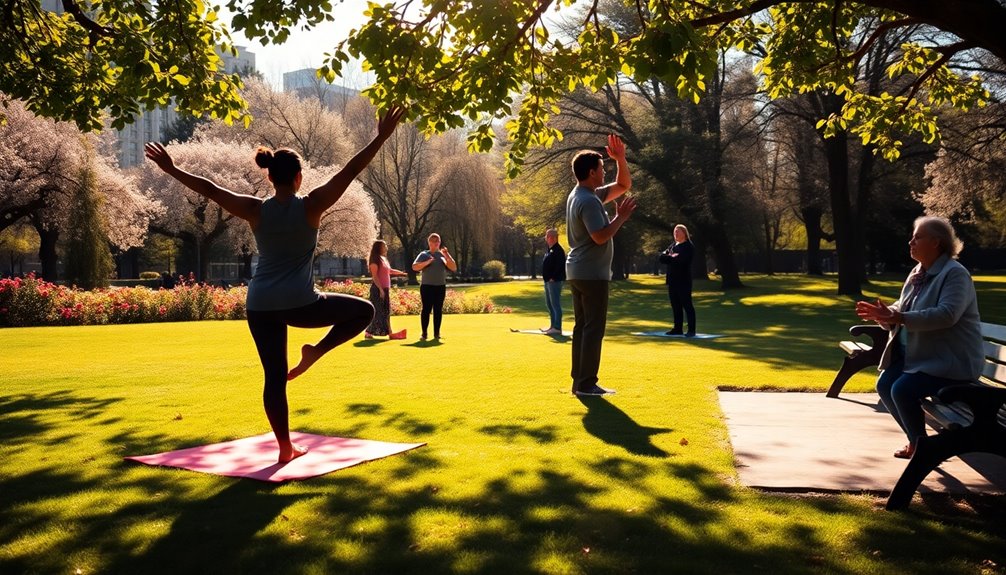To incorporate mindful practices into your daily routine, start each day with a moment of meditation and deep breathing. As you move through your day, engage in mindful eating by savoring your meals and limiting distractions. Consider adding mindful movement activities like yoga or walking meditation to connect with your body. Create a journaling habit to reflect on your thoughts and practice gratitude each day. Set reminders to pause and breathe throughout the day. These simple changes can promote calm and clarity. If you'd like to explore more techniques, there are plenty of effective strategies to enhance your mindfulness practice.
Key Takeaways
- Begin each morning with a short meditation focused on breath, setting a mindful tone for the day ahead.
- Practice mindful eating by dedicating time to meals, savoring each bite, and creating a calm dining environment.
- Incorporate mindful movement through activities like yoga, walking meditation, or Tai Chi to connect with your body and surroundings.
- Engage in mindfulness journaling to explore thoughts and feelings, using prompts to deepen self-reflection and awareness.
- Take brief moments throughout the day for mindful breathing to enhance clarity and reduce stress in daily activities.
Start Your Day Mindfully

Starting your day mindfully can set a positive tone for everything that follows. When you wake up, instead of diving straight into your to-do list, take a moment to center yourself. Consider incorporating morning meditation into your routine. Just five to ten minutes of quiet reflection can help you tune into your thoughts and feelings. You might want to focus on your breath or visualize a peaceful scene. This practice not only cultivates a sense of calm but also allows you to approach the day with intention.
Once you've grounded yourself with meditation, try mindful stretching. Engaging in gentle stretches can awaken your body and promote a feeling of connectedness. As you stretch, pay attention to how your muscles feel and how your body moves. Notice the sensations without judgment. This can be a wonderful way to foster self-awareness and acceptance.
Combining morning meditation and mindful stretching creates a holistic start to your day. You'll feel more present and prepared to face whatever comes your way. These practices foster a sense of belonging, both to yourself and to the world around you. As you cultivate mindfulness in the mornings, you might find it easier to carry that awareness into the rest of your day.
Practice Mindful Breathing

Taking a moment to practice mindful breathing can greatly enhance your overall sense of calm and presence. By focusing on your breath, you can create a serene space in your day, helping you feel grounded and connected. It's a simple yet powerful tool to incorporate into your routine, whether you're at home, at work, or on the go.
Here are some practical tips to get started with mindful breathing:
- Find a Comfortable Position: Sit or lie down in a way that feels natural for you.
- Close Your Eyes: This helps you eliminate distractions and focus inward.
- Inhale Deeply: Fill your lungs completely, counting to four as you breathe in.
- Exhale Slowly: Release your breath for a count of six, allowing tension to melt away.
These breathing exercises can be a beautiful complement to your mindful meditation practice. They require little time and effort but can yield immense benefits.
When you take just a few minutes to focus on your breath, you're inviting a sense of clarity and peace into your life.
Engage in Mindful Eating

Savoring each bite of your food can transform your meals into a mindful experience that nourishes both your body and mind. When you engage in mindful eating, you're not just consuming food; you're embracing a ritual that encourages you to truly connect with what you're eating. Start by creating a calm environment. Turn off distractions like your phone or TV, and sit at a table where you can focus on your meal.
As you begin to eat, take a moment to appreciate the colors, textures, and aromas of your food. This is your opportunity to practice presence. Notice how the flavors unfold on your palate. Savor flavors by chewing slowly and allowing yourself to fully experience each mouthful. This not only enhances your enjoyment but also helps you recognize when you're full.
You might find it helpful to set aside dedicated time for meals, even if it's just a few minutes during a busy day. This small commitment can turn eating into a cherished moment of self-care. Incorporating mindfulness meditation into your daily routine can further enhance your overall awareness during meals.
Invite family or friends to join you, turning mealtime into a shared experience. Engaging in meaningful conversation while eating can deepen your connections and enrich your experience.
Incorporate Mindful Movement

Incorporating mindful movement into your daily routine can transform the way you connect with your body and enhance your overall well-being. When you engage in movement mindfully, you become more aware of your body's sensations and rhythms, fostering a deeper sense of belonging to yourself and the world around you. Here are some practical ways to embrace mindful movement:
- Mindful Yoga: Focus on your breath and the sensations in your body as you flow through each pose. This practice not only strengthens your body but also calms your mind.
- Walking Meditation: Take a slow, intentional walk, paying attention to each step and the feeling of the ground beneath your feet. Notice the sights, sounds, and smells around you.
- Body Scan: Lie down comfortably and systematically bring your attention to each part of your body, noticing any tension or relaxation. This practice helps you connect with your physical self.
- Tai Chi: Engage in this gentle martial art that combines slow, flowing movements with mindfulness. It's an excellent way to enhance balance and reduce stress.
Create a Mindfulness Journal

Mindful movement helps you connect with your body, and creating a mindfulness journal can further deepen that connection. A mindfulness journal is a safe space for you to explore your thoughts and feelings, fostering a sense of belonging within yourself. By engaging in mindful reflection, you cultivate awareness and understanding of your inner world. Incorporating dynamic exercises into your routine can enhance your overall mindfulness practice.
To get started, consider these journal prompts that encourage deeper reflection:
| Date | Prompt | Reflection |
|---|---|---|
| Day 1 | What am I grateful for today? | List three things and why. |
| Day 2 | How did I feel this morning? | Describe your emotions. |
| Day 3 | What challenge did I face? | Reflect on how you managed it. |
| Day 4 | What brings me joy? | Identify activities or people. |
As you write, let your thoughts flow without judgment. You might find that expressing yourself helps unravel complex emotions and connects you to your experiences. Aim to write a few times a week, allowing your journal to become a trusted companion.
Limit Digital Distractions

Digital distractions have become a constant presence in our lives, often pulling our attention away from what truly matters. With the average person spending over seven hours on screen time daily, it's no wonder we feel overwhelmed. To regain control, consider implementing a digital detox to help you reconnect with yourself and your surroundings.
Here are a few practical steps to limit those distractions:
- Set specific screen time limits: Choose how much time you want to spend on your devices each day. Use apps to track this and hold yourself accountable.
- Create tech-free zones: Designate certain areas in your home—like the dining table or bedroom—where electronics aren't allowed. This fosters connection with family or encourages relaxation.
- Schedule regular breaks: Instead of mindlessly scrolling, plan short breaks to step away from screens. Use this time to take a deep breath, stretch, or enjoy a quick walk.
- Engage in offline activities: Rediscover hobbies that don't involve screens, like reading, drawing, or gardening. These activities can bring a sense of fulfillment and joy. Additionally, engaging in activities that promote relaxation can help lower high blood pressure and improve overall well-being.
Cultivate Gratitude Daily

Gratitude can be a powerful tool for enhancing your well-being and shifting your perspective. When you take a moment each day to acknowledge what you're thankful for, you create a positive mindset that can transform your experiences.
Cultivating gratitude doesn't have to be complicated; it can be as simple as incorporating a few gratitude exercises into your routine.
Start by listing three things you're grateful for each morning. You might find that writing them down makes the experience even more impactful. This daily ritual sets a positive tone for your day and helps you focus on the good around you.
You can also try daily affirmations that emphasize gratitude. For instance, saying, "I'm thankful for the love and support in my life" can reinforce your appreciation for those connections.
Another effective gratitude exercise is to share your appreciation with others. Send a quick text or email to someone you're grateful for, letting them know how they've positively impacted your life. This not only strengthens your bond with them but also enhances your own feelings of gratitude.
Use Mindfulness Reminders

Incorporating reminders throughout your day can greatly enhance your ability to stay present and engaged. Mindfulness reminders act as gentle nudges, helping you pause and reconnect with the moment. Here are some practical ways to integrate them into your routine:
- Set alarms on your mindful phone: Use specific tones or messages that prompt you to take a deep breath or observe your surroundings.
- Wear a reminder bracelet: Choose a bracelet that symbolizes your mindfulness journey. Every time you notice it, take a moment to reflect or breathe deeply.
- Post sticky notes: Place them in visible spots like your desk or bathroom mirror with encouraging phrases like "Breathe" or "Stay present."
- Schedule mindful breaks: Block out time in your calendar for short mindfulness practices, reminding yourself to step away from tasks and reconnect.
Reflect Before Sleep

As your day winds down, taking a moment to reflect before sleep can greatly enhance your mindfulness practice. Engaging in bedtime reflections allows you to process the day's events, acknowledge your feelings, and cultivate a sense of gratitude. It's a simple yet powerful way to ground yourself and foster a deeper connection to your thoughts and emotions.
One effective method is dream journaling. Keep a notebook beside your bed, and jot down any thoughts or dreams that come to mind. This practice not only helps you capture fleeting ideas but also encourages clarity and introspection. When you read your entries, you may uncover patterns or insights that guide your mindfulness exercises.
Another helpful technique is sleep meditation. Before drifting off, dedicate a few minutes to focus on your breath or visualize a peaceful scene. This practice calms your mind, making it easier to let go of the day's stress and embrace a restful night. You might even combine this with your bedtime reflections, allowing your thoughts to flow freely as you slip into a meditative state. Incorporating brainwave guidance technology, like 3xPureTone™ technology, can further enhance your meditation experience.
Incorporating these mindful practices into your nightly routine can create a sense of belonging within yourself, fostering self-acceptance and awareness. So, as you lay down to sleep, give yourself the gift of reflection. Embrace the quiet moments, allowing them to nourish your mind and spirit for the day ahead.
Frequently Asked Questions
Can Mindfulness Help Reduce Anxiety and Stress Levels?
Absolutely, mindfulness can help reduce anxiety and stress levels. By practicing mindfulness techniques like deep breathing or body scans, you're training your mind to focus on the present moment. This awareness allows you to recognize anxious thoughts without judgment, creating space for calmness.
You'll start to notice mindfulness benefits, such as improved emotional regulation and resilience. Remember, you're not alone in this journey; many find peace through these practices.
How Long Does It Take to See Benefits From Mindfulness?
You might wonder about the mindfulness timeline for seeing benefits. Generally, with consistent practice, many people notice improvements in as little as a few weeks. The key is mindfulness consistency; the more regularly you engage in mindful activities, the quicker you'll experience stress reduction and emotional balance.
Can Children Practice Mindfulness Effectively?
Can children really practice mindfulness effectively? Absolutely! With your guidance in mindful parenting, you can introduce them to simple mindfulness exercises. These activities help kids focus, manage emotions, and develop empathy. By creating a supportive environment, you encourage their curiosity and growth. Just remember, it's all about making it fun and relatable.
When you practice together, you not only strengthen your bond but also instill lifelong skills for emotional well-being.
What Are Some Common Misconceptions About Mindfulness?
You might think mindfulness is just about sitting in silence or emptying your mind, but that's a misconception. It's more about being present and aware of your thoughts and feelings.
The benefits of mindfulness extend beyond relaxation; it can reduce stress and improve focus. There are various mindfulness techniques, like deep breathing or body scans, that fit into anyone's lifestyle.
Embracing these practices can foster a deeper sense of belonging and connection with yourself and others.
How Do I Maintain Mindfulness During Stressful Situations?
When stress hits like a thunderstorm, you can find your rainbow through breathing techniques and grounding exercises. Start by taking deep breaths, picturing calm waves washing over you.
Next, plant your feet firmly on the ground, feeling the earth's support. This connection helps anchor you in the moment, reminding you that you're not alone in this.
Embrace these practices, and you'll navigate those turbulent waters with grace and resilience.
Conclusion
Incorporating mindful practices into your daily routine can profoundly enhance your well-being. Research shows that regular mindfulness can reduce stress levels by up to 30%, helping you navigate life's challenges with greater ease. By starting your day mindfully, savoring meals, and reflecting before sleep, you can cultivate a richer, more present experience. Remember, it's about progress, not perfection. Take small steps, and soon, these mindful habits will become a natural part of your life, fostering peace and clarity.



